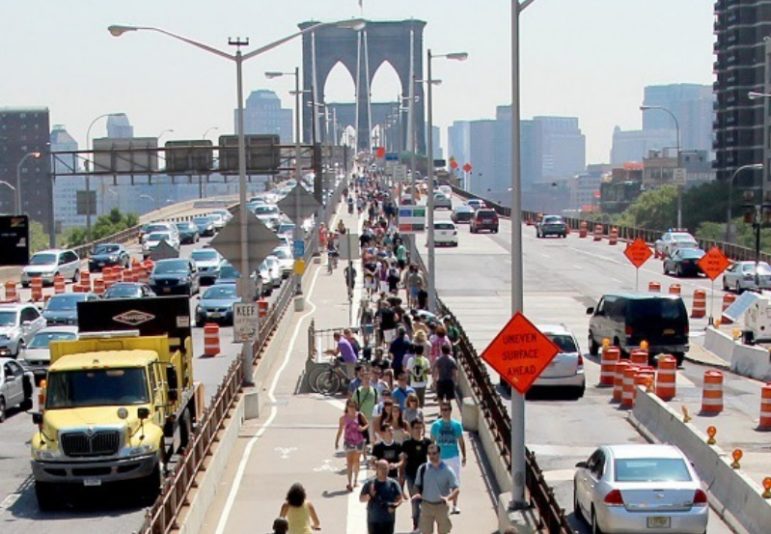
NYMTC
Transportation has been a hot topic this summer, especially for those who use New York’s transportation system on a daily basis.
It hasn’t been easy. There have been delays and cancellations due to planned repair work at Penn Station, the busiest transit hub in the Western Hemisphere; heightened congestion on our roadways; and ongoing maintenance and equipment issues in our subways.
In order to ease the many strains already facing our transportation system, regional planning is needed. How do we support and improve the shared transportation network in New York City, the lower Hudson Valley and Long Island? It’s achieved through preparation, collaboration and planning – enough planning to take us to 2045, to be exact.
The New York Metropolitan Transportation Council (NYMTC) is the Metropolitan Planning Organization (MPO) for New York City, Long Island and the lower Hudson Valley. Our 10-county region, which includes the five boroughs of New York City, plus Nassau, Suffolk, Westchester, Putnam and Rockland counties, is home to more than 12 million people. NYMTC Council Members are elected officials and heads of federal, city and state transportation, planning and environmental agencies. Collectively, the MPO undertakes a federally-mandated planning process in order to access federal funding for future transportation projects.
One thing is for sure: Our transportation system is one of the largest and most utilized networks in the world. It is very unique to New York but has regional implications for those trying to enter from the tri-state area and beyond. When looking at available data for travel patterns in the New York metropolitan area for 2016’s fourth quarter, as compiled by NYMTC, approximately 10.2 million people utilized the bus and the rails to get to where they need to go, roughly 2 million vehicles crossed our region’s bridges and tunnels and more than 106,000 riders used the ferry on an average weekday.
However, when forecasts tell us that an additional 2 million people could be added to our region over the next 28 years, adding millions of daily passenger trips by bus, rail rapid transit, commuter rail, ferries and private vehicles – as well as millions of tons of freight moving by truck, rail and water – you can imagine what this could mean for our regional transportation system.
Plan 2045, NYMTC’s Regional Transportation Plan, was adopted in June and lays out the shared vision for the planning region with a focus on sustainability and innovation for NYMTC’s regional transportation system. Plan 2045 encompasses all facets of transportation, including roads, bridges, mass transit facilities, bicycle and pedestrian networks, goods movement and transportation for those with special needs. Adoption of Plan 2045 included approval of its accompanying planning products that are required to qualify for federal transportation funding. These include the 2017 Congestion Management Process (CMP) Status Report – a tool that forecasts future traffic congestion and considers strategies to reduce overall congestion – and the Transportation Conformity Determination, which analyzes how future transportation projects can impact future mobile source emissions.
NYMTC’s Regional Transportation Plan contains hundreds of preservation and enhancement projects meant to address current stressors and implement improvements to better the transportation system. Some examples of the larger enhancement projects include the Lower Hudson Transit Link, the Moynihan Station in New York City, the Goethals Bridge replacement in Staten Island, the East Side Access project for the Metropolitan Transportation Authority’s Long Island Rail Road, Vision Zero updates to Queens Boulevard and the Nassau Hub Transit Initiative in Nassau County.
More than ever before, the resiliency and sustainability of our transportation system is needed to help with the overall growth and strain we see every day in our region. Plan 2045 allows us to maintain and develop a transportation system for tomorrow. While Plan 2045 is considered to be a blueprint that is truly the shared vision for our regional transportation system, it is a working document that will see changes as needs change within the region.
That’s why the transportation system of tomorrow needs to be considered today. This summer we have seen why we all must work together to properly prepare for and invest in regional transportation planning for the long haul. It is never too early to look at how investments can improve the quality of life and ease the concerns for all those that rely on the transportation system. Keeping an open mind and thinking outside the box when it comes to pedestrian networks, bike lanes – and emerging technologies that can improve mobility and connectivity such as autonomous vehicles – is the direction we all need to go.
Innovative thinking and research is currently happening to create and develop systems in our transportation network that will impact everyone. Regional long-range planning can help make sure we are all better equipped for the future.
José M. Rivera, P.E. is the Executive Director of the New York Metropolitan Transportation Council.








